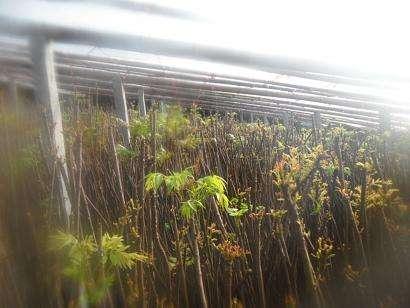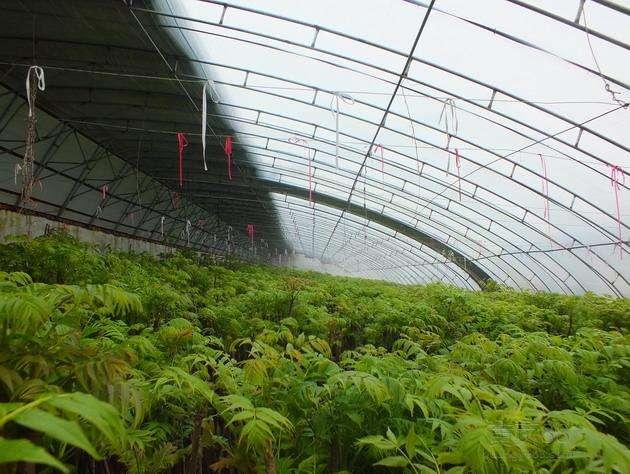Planting Toona sinensis Bud in greenhouse in Winter
Planting Toona sinensis in the greenhouse in winter is actually transplanting one or two-year Toona sinensis seedlings in the open air into the greenhouse in winter, planting them in high-density false planting over the winter, waiting until the ground buds are listed in spring and then moving out of the greenhouse, staggering the normal listing season, and increasing production at the same time. Improve economic benefits, is now a more commonly used planting technology. The following is a brief introduction to this technology, because the editor's main business is mainly to raise seedlings, so it may not be comprehensive, if some experts find deficiencies also hope to correct ha!
First, build a shed
The greenhouse is almost the same, basically high in the north and low in the south, covered with film and straw felt, as for the size, depending on their own situation, the basic size of the growers here is about 20 meters long and 7 meters wide.

Second, transplant into the shed
During the period from Frosts Descent to the Beginning of Winter, usually around November, when the leaves of Toona sinensis planted in the open air have basically fallen, they are transplanted into the greenhouse. Dig a deep trench of about 30 centimeters in the greenhouse, leaving an aisle of about 40 centimeters between three or four ditches in the east-west direction, put the Toona sinensis seedlings in bundles into the ditches, and bury the roots with backfill soil, because the Toona sinensis seedlings at this time are actually pseudo-planted, so the density can be very high, with an average of 8 to 100000 trees per mu! It should be noted here that if the Chinese toon tree wants to sprout, it must have a period of low temperature dormancy for a period of about 20 days, that is to say, at least 15 days after the fallen leaves can enter the shed. If the leaves have not fallen when the seedlings are selected, the leaves need to be bare. Open-air pseudo-planting for more than half a month to enter the shed, otherwise either the germination rate is not good, or directly does not germinate. After entering the shed, it is generally not necessary to apply fertilizer, but after planting in the shed, it is necessary to pour a lot of water to make the seedlings of Toona sinensis store enough water.

Third, temperature and humidity
About 10 days after planting, the temperature in the shed was kept at 15-20 degrees during the day and 14 degrees at night, and then gradually increased. In general, the temperature in the greenhouse is 2930 degrees during the day and 14 degrees at night. The terminal bud should be properly cooled after germination, properly ventilated to about 25 degrees, to ensure that the temperature difference between day and night is more than 10 degrees, and the air relative humidity should be kept at 80% to 90%.

IV. Picking
Generally, before and after the Beginning of Spring, the toon buds in the greenhouse can be picked and grow to about 20 centimeters. Pick the top buds. If they are not sold immediately, it is best to stand in two to three centimeters of water to prevent wilting.

From picking to March and April, when the buds of Toona sinensis are normally picked and put on the market, the closely planted Toona sinensis buds are removed from the greenhouse and reloaded into the ground. The survival rate of Toona sinensis trees is very high, so there is no problem with frequent transplanting. It should be noted that in order to facilitate picking in the second year and increase the yield, the terminal buds can be removed and dwarfing can be achieved. Most of the people who buy Chunya seedlings from the editor are planted in the greenhouse, with high output and good benefits. Of course, this also depends on the region. After all, no industry is sure to make money, and we share technology, but there is no intention of advocating it.
Welcome to follow, thank you for reading!
- Prev

High-yield potato planting techniques: potato planting technology and management, integrated control of potato diseases and insect pests
Potato is the most important food crop used as human staple food except grain in the world, and it mainly eats its underground tubers. Widely planted all over the world.
- Next

A legal marijuana growing base!
Kentucky, USA: in 2013, Senate Bill 50 (Senate Bill50), the legislative proposal of Kentucky Agriculture Commissioner Comer, was passed.
Related
- Fuxing push coffee new agricultural production and marketing class: lack of small-scale processing plants
- Jujube rice field leisure farm deep ploughing Yilan for five years to create a space for organic food and play
- Nongyu Farm-A trial of organic papaya for brave women with advanced technology
- Four points for attention in the prevention and control of diseases and insect pests of edible fungi
- How to add nutrient solution to Edible Fungi
- Is there any good way to control edible fungus mites?
- Open Inoculation Technology of Edible Fungi
- Is there any clever way to use fertilizer for edible fungus in winter?
- What agents are used to kill the pathogens of edible fungi in the mushroom shed?
- Rapid drying of Edible Fungi

